Gross domestic product grew by 1.0 per cent in 2019
The volume of gross domestic product grew by 1.0 per cent last year. Calculated at current prices, gross domestic product was 2.8 per cent higher than in 2018.
In October to December, gross domestic product contracted by 0.7 per cent from the previous quarter but grew by 0.4 per cent compared to the fourth quarter of 2018. According to preliminary data compiled by Eurostat, gross domestic product in the EU27 area grew by 0.1 per cent in the last quarter of 2019 compared with the previous quarter.
Figure 1. Volume change of GDP from the previous quarter, seasonally adjusted, per cent
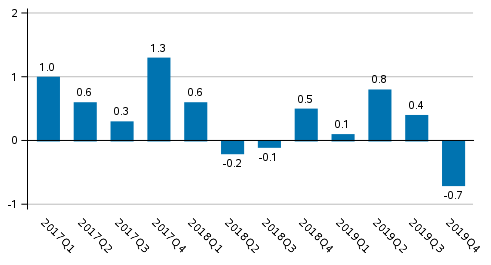
Finland's national economy grew in 2019 due to strong development in the second and third quarters. In the first quarter, the change of GDP from the previous quarter was only marginally positive. At the end of the year, the output of the national economy contracted.
Economic growth in 2019 came from several manufacturing and service industries. The big growth in the electrical and electronics industry in earlier statistical releases has now been assessed as more moderate, which in part had an effect on the GDP growth figures as well. The volume of value added diminished in some industries, such as the forest industry and financial and insurance activities.
The unemployment rate was lower in 2019 than in the previous year and the employment rate higher than in 2018.
Output
In the fourth quarter, the combined volume of value added generated by industries contracted by 0.7 per cent from the previous quarter. In the whole of 2019, value added was 1.2 per cent higher than in the year before.
Several manufacturing and service industries grew in 2019, but value added in agriculture, forestry, construction, and financial and insurance activities diminished.
Figure 2. Changes in the volume of value added generated by industries in 2019 compared to one year ago, per cent
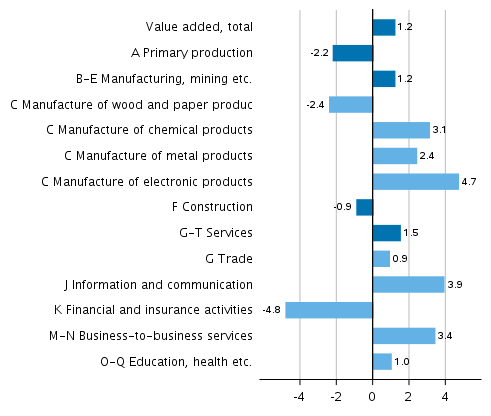
Figure 3. Changes in the volume of value added generated by industries in the fourth quarter of 2019 compared to one year ago, working-day adjusted, per cent
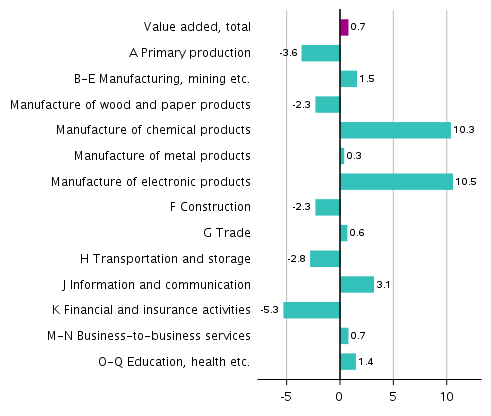
Figure 4. Changes in the volume of value added generated by industries in the fourth quarter of 2019 compared to the previous quarter, seasonally adjusted, per cent
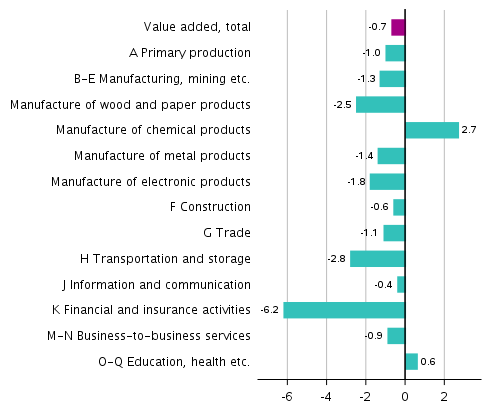
The volume of value added in primary production, that is, agriculture, forestry and fishery, declined by four per cent in October to December from one year ago. In the whole of 2019, primary production decreased by two per cent.
Value added in manufacturing (industries B to E) grew by 1.2 per cent in 2019 and in the last quarter by two per cent compared to one year ago. The volume of the metal industry grew in 2019 by two per cent and the chemical industry by three per cent. The forest industry contracted by two per cent and energy and water supply by one per cent.
The electrical and electronics industry is estimated to have grown by five per cent in 2019. At this stage, there is more uncertainty than usual in the data of the enterprise sector for 2019. The available data give a fairly good picture of enterprises’ income, but data on expenses will not be received until later in spring.
In October to December, the volume of value added in construction decreased by two per cent from one year previously. In the whole of 2019, construction decreased by one per cent.
From October to December, the volume of value added in service industries increased by one per cent from the quarter of one year ago. Over the whole year 2019, service industries grew by 1.5 per cent. Private services increased by two per cent. Most growth was seen in accommodation and food service activities, information and communication and business services. General government services remained unchanged from 2018
Imports, exports, consumption and investments
In 2019, total demand in the national economy grew by 1.3 per cent from the previous year. Demand was particularly boosted by growth in exports.
Figure 5. Changes in the volume of main supply and demand items in 2019 compared to one year ago, per cent
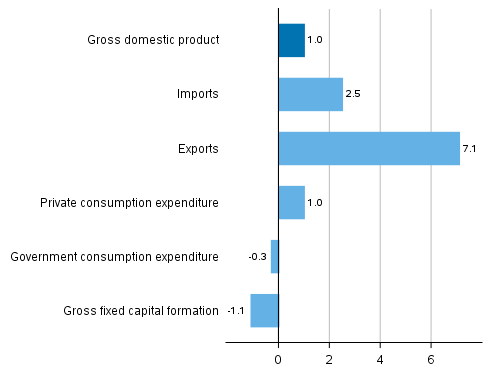
Figure 6. Changes in the volume of main supply and demand items in the fourth quarter of 2019 compared to one year ago, working-day adjusted, per cent
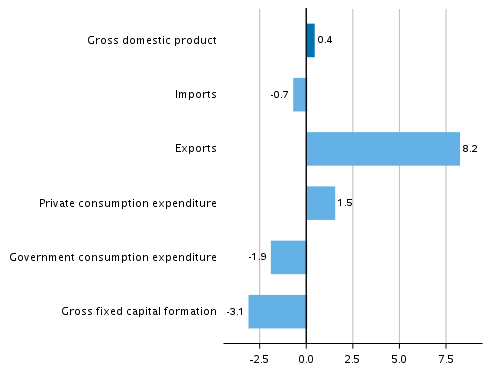
Figure 7. Changes in the volume of main supply and demand items in the fourth quarter of 2019 compared to one year ago, seasonally adjusted, per cent
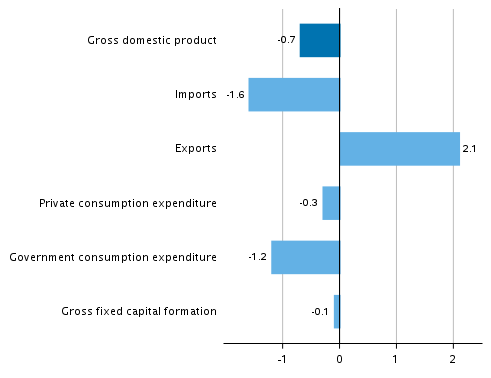
In October to December, the volume of exports increased by eight per cent year-on-year. The volume of imports decreased by one per cent. In the full year 2019, the volume of exports grew by 7.1 per cent: the volume of goods exports went up by three per cent and that of service exports by as much as 16 per cent. The volume of imports went up by 2.5 per cent: the volume of goods imports went down by one per cent, but service imports grew by nine per cent.
In the last quarter of 2019, private consumption decreased slightly from the previous quarter but grew by nearly two per cent year-on-year. In the whole year, the volume of private consumption expenditure grew by 1.0 per cent.
The volume of government consumption expenditure decreased in October to December by one per cent from the previous quarter and by two per cent from the previous year. In the whole of 2019, the volume of government consumption expenditure went down by 0.3 per cent.
The volume of gross fixed capital formation, that is, investments decreased in the last quarter of 2019 by three per cent from one year ago. Over the whole year, investments decreased by 1.1 per cent. The volume of building investments went down by one per cent, the volume of investments in machinery, equipment and transport equipment by half a per cent, and investments in research, development and software by three per cent.
Employment, wages and salaries and national income
In October to December, the number of employed persons was 0.5 per cent higher than in the previous quarter. The number of hours worked in the national economy decreased by 0.1 per cent from the previous quarter.
In 2019, the number of employed persons grew by 0.9 per cent and the number of hours worked by 0.8 per cent from the year before. According to Statistics Finland’s Labour Force Survey, the unemployment rate was 6.0 per cent in October to December, that is, as high as one year earlier. In the whole of 2019, the unemployment rate was 6.7 per cent, having been 7.4 per cent in the year before.
Labour productivity, or the volume of gross value added per hour worked, grew by 0.4 per cent last year.
The nominal wages and salaries bill of the national economy grew by 3.1 per cent. Social contributions paid by employers declined by 2.0 per cent from last year.
The operating surplus (net), which in business bookkeeping corresponds roughly with operating profit, grew by 4.8 per cent from 2018. Gross national income was 2.4 per cent higher in nominal terms than in the previous year.
The available data
The preliminary data are based on the source information on economic development available on 25 February 2020. The annual level data for 1990 to 2018 correspond with the National Accounts data released on 31 January 2020, except for those on the rest of the world sector (imports, exports, primary income from/to the rest of the world), which may have become revised.
The preliminary data for 2019 that contain more detailed data on general government and other sector accounts will be released on 16 March 2020. The data of the 2018 Annual National Accounts and this release will be revised at that time. The revised data will also be updated in the database tables of the Quarterly National Accounts, but no actual release of the Quarterly National Accounts will be compiled.
National Accounts for 2019 with more detailed data contents will be released on 18 June 2020.
Data concerning the first quarter of 2019 will be released on 29 May 2020, when the data for previous quarters will also be revised. A flash estimate on GDP development for January to March will be released in connection with the Trend Indicator of Output on 15 May 2020.
Due to the benchmarking and seasonal adjustment methods, quarterly data in the entire time series may become slightly revised in connection with each release. However, the largest revisions take place during the two to three years following the release on a quarter, because final annual accounts data are published at a lag of around two years from the end of the statistical reference year. Seasonally adjusted and trend time series always become revised against new observations irrespective of whether the original time series becomes revised or not.
The quality description is available on Statistics Finland's website: http://www.tilastokeskus.fi/til/ntp/laa.html .
Methodological description of Quarterly National Accounts.Source: National Accounts 2019, 4th quarter. Statistics Finland
Inquiries: Samu Hakala 029 551 3756, Antti Kosunen 029 551 3613, kansantalous.suhdanteet@stat.fi
Director in charge: Jan Nokkala
Updated 28.2.2020
Official Statistics of Finland (OSF):
Quarterly national accounts [e-publication].
ISSN=1797-9765. 4th quarter 2019,
Gross domestic product grew by 1.0 per cent in 2019
. Helsinki: Statistics Finland [referred: 24.12.2025].
Access method: http://stat.fi/til/ntp/2019/04/ntp_2019_04_2020-02-28_kat_001_en.html

